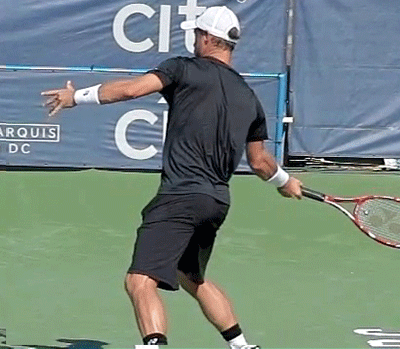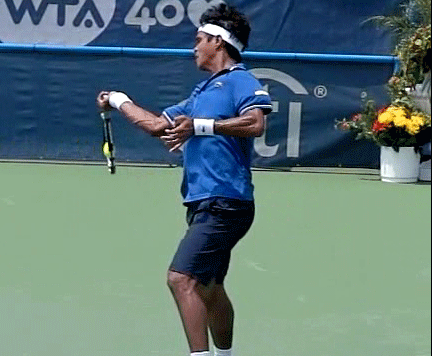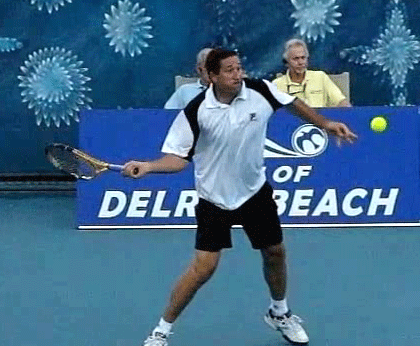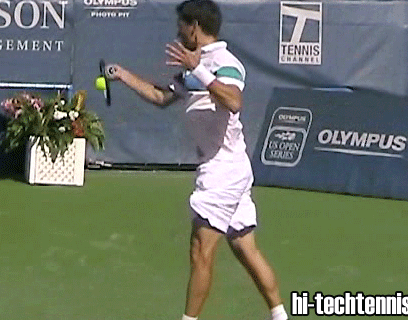Face It!

It's a Rotation and a Pull, Not a Swing
Frank Early's observation that pro players "FACE" the ball on contact by timing their shoulder/hip rotation and bringing their hitting shoulder forward, is one of the most important insights into the modern forehand. Not only is it the proper way to teach the forehand, but it also sheds light on why traditional tennis instruction is so ineffective in teaching this stroke.
Traditional tennis instruction thinks of the forehand as a "swing". And usually the recommendedation is to have a "long swing" for more power. The longer the swing the more power right? I recently subscribed to a site that promised to tell you how add more power to your forehand. His main tip? "Lengthen the runway". Again - it's this notion of a long swing that just dominates the teaching world.
The modern forehand does not, in any way, look like a "swing", let alone a "long swing". Instead, it is based on ROTATION and LEVERAGE. The modern forehand uses the arm as a "hitting structure" (or "frame" - a nice term used by Doug King) to create a solid wall-like structure on contact for maximum spring and compression of the ball into the racket. And the "swing" is really a rapid 90 degree rotation of the shoulders that face - (or as Doug King likes to say "square up to") - the net on contact. This rapid rotation, combined with a pull of the arm forward for leverage, is the way top players meet the ball before lifting it, driving it, and turning it in a powerful "windershield wiper" motion.
The Robby Ginepri animation shows just how compact and powerful these principles of rotation and leverage make the stroke. You can see, clearly, how Ginepri turns into the ball and is "facing the target at the moment of contact", exactly as Frank Early describes in his brilliant book "Tennis Strokes That Win". Notice how his arm is configured in a bent position that is establshed "in the slot" and doesn't change as it gets rotated around by the shoulders and pulled forward by the upper arm.


Leverage Like a Boxer
I highlighted the arm and racket configuration as Ginepri makes contact with the ball. You can see how the ball is compressing into what is, in effect, a powerful wall. The racket is supported by the bent arm configuration. And the bent arm is supported by the shoulder. When Frank Early writes "moving your hitting shoulder forward creates the best overall position for hitting the ball in front of your center of gravity", this is what he is referring to.
If Ginepri were delivering an upper cut punch, his arm would be in a perfect position. Compare Ginepri's contact position to that of a boxer delivering an uppercut punch. The boxer has squared up to his target and his bent arm has been pulled/lifted well in front of his body. His shoulder is directly supporting and driving his arm. He is not punching with just his fist. He is using his shoulder to drive his entire bent arm to dforward - and more importantly here - upward.

If we look at a professional forehand from the opposite side, you can really see how "face it" puts the arm and body in a strong punching position on contact. Hewitt is rotating his shoulders 45 degrees into contact while he also brings his bent arm forward to contact. It's a very powerful and quick turn of the body. It's not a "swing" of his arm.
On contact, Hewitt's shoulders, his hips, and his racket are directly facing the net. You can see his right elbow on contact because it is positioned in front of the plane of his body. This motion is not a "swing" the way we think of a swing in tennis. Instead, Hewitt is rotating his body to deliver his arm to the ball. And he is lifting and pulling his bent hitting arm forward to meet the ball in front. On contact, he is in a perfect position to lift the ball for topspin and to push the ball for power. His right shoulder is positioned behind his bent arm which is behind his hand and racket.

So practice this critical body positioning on contact. Have your shoulders and hips face the net. Have your bent arm positioned in front of your body. And feel how this position enables you to powerfully push and lift the ball. Rotate your shoulders sideways about 45 degrees away from the net. Now practice "FACE IT" by squaring up to the ball and meeting it in front of your body. Keep your arm in the same bent position as your rotate your shoulders and bring/pull your arm forward to the ball so that your elbow is just in front of your body plane. Take the swing out of your stroke and tap into the pro power of rotation and leverage instead.
Traditional instruction almost always begins with some sort of takeback reference point followed by some sort of finish reference point. But the critical contact point is never explicity taught. So most players will never know what it feels like to have the body properly positioned behind the ball on contact. They take bigger and faster "swings" with their arm, and it's just wasted energy because at the critical moment of impact, the racket, arm, and shoulder aren't positioned properly.

When I teach someone the forehand, I always start with them in this contact position first so they know what contact is supposed to feel like. The rest of stroke then gets created around this critical contact position.
The reference points for "FACING" the ball on contact are:
- The hips and shoulders are facing the net
- The elbow is positioned in front of the body plane.
- The torso is straight up and down (it's the axis around which you rotate)
- The racket is angled downward to varying degrees to aid in lifting the ball.
- Time your rotation into the ball so that you "square up" exactly at contact



